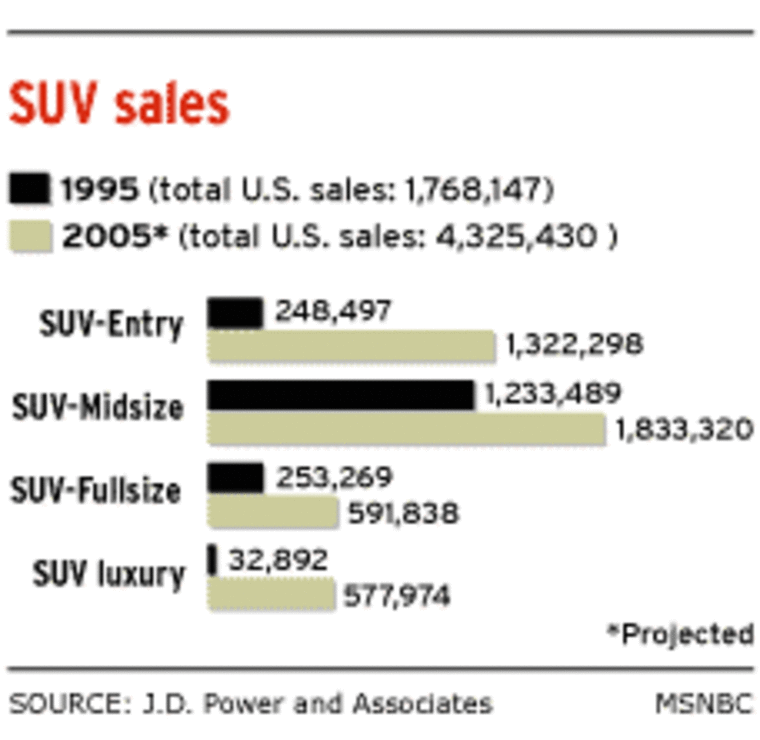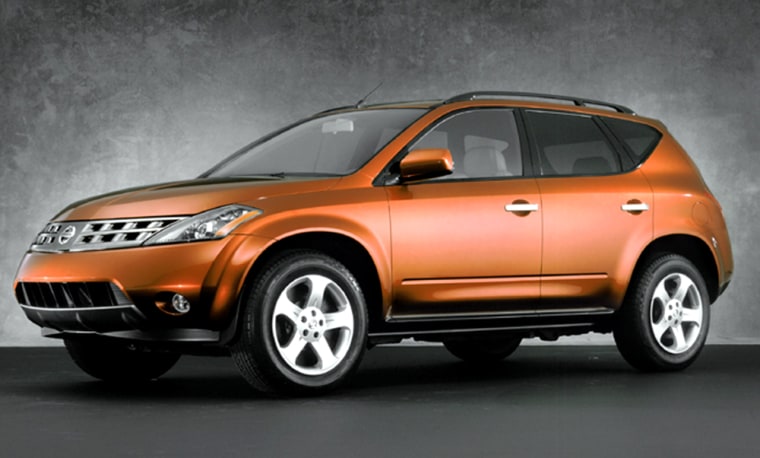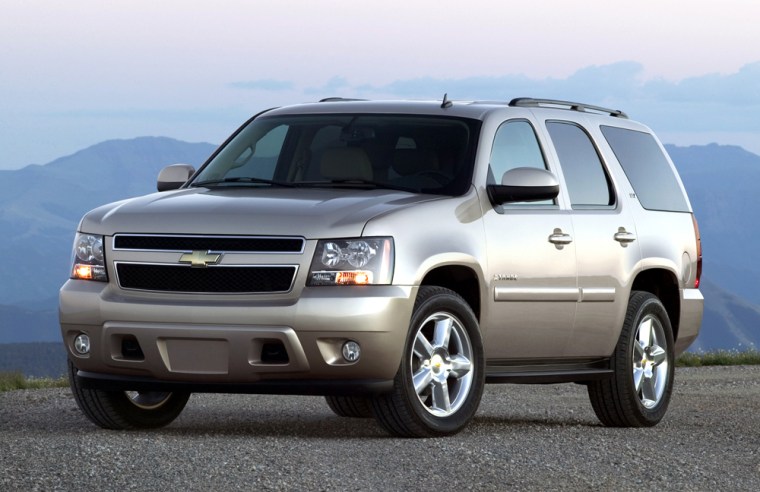Sales of big sport utility vehicles have tumbled over the past several months in the wake of $3-a-gallon gasoline, but don’t try telling General Motors Corp. that the behemoths of the road are running on fumes.
Even as consumer tastes appear to be shifting away from big SUVs toward smaller, more fuel-friendly "crossover" models, the No. 1 automotive company is preparing a major overhaul of its some of its biggest — and most profitable — consumer vehicles, including the Chevrolet Suburban, GMC Yukon and Cadillac Escalade.
“The bottom line for us is the utility market remains the largest category in the industry,” said Paul Ballew, GM's executive director of global market and industry analysis. “We are anticipating we will maintain our share of a stable market that is still very profitable.”
Even though Detroit has been roundly criticized for its overdependence on big, truck-based vehicles, industry analysts and executives say it is far too soon to begin writing the obituary on the SUV category, which rocketed to prominence in the 1990s and now accounts for one of every four vehicles that roll off dealer lots.
They are even more important to the industry in terms of profitability.
A typical big domestic-made SUV generated $6,300 in profits for the Big Three automakers in 2004, compared with $3,800 for a full-size car. A large luxury SUV like an Escalade added an average of $11,300 to the bottom line of its manufacturer, compared with $8,100 for a typical luxury car, according to data from the University of Michigan Transportation Research Institute.
And while hot-selling smaller crossover vehicles like the Nissan Murano, Honda Pilot and Chevrolet Equinox — utility vehicles built on car platforms — might be good substitutes for medium-sized SUVs, analysts and industry executives say there is still plenty of demand for large vehicles that haul like a truck but offer at least some of the comforts of a car.
“The huge growth in large SUVs is essentially over,” said Jack Nerad, editorial director and executive market analyst for Kelley Blue Book, which tracks the industry. “At the same time there is going to be a very significant market for large SUVs like the Chevy Tahoe. There are just too many people who need what a large SUV does for them.”

While Ford and DaimlerChrysler also rely heavily on sales of SUVs, nobody has more riding on the large end of the category than General Motors. The No. 1 carmaker has seen its overall market share tumble over the past year, had its corporate bonds downgraded to junk status and announced plans to cut 30,000 jobs and close several plants.
GM historically has dominated the large end of the SUV market with its Suburban, Tahoe and Yukon models, but sales of all three have tumbled this year, including a 26 percent drop for the Suburban. GM executives acknowledge that concern over fuel prices has played a role but say the main reason is the models have gotten stale and consumers are anticipating a major redesign.
So GM hopes to make a big splash early this year — think Super Bowl advertising — with the launch of the 2007 Tahoe and Yukon, the first of a half-dozen SUV models based on the new GMT-900 pickup truck platform. The new platform includes a redesigned chassis that GM promises will offer a smoother ride, among other improvements.
“We are breaking all new ground, certainly with regard to fuel economy and safety,” said GM’s Ballew.
GM has begun taking the wraps off its new models for automotive writers, and the early reviews have been positive, said Jesse Toprak, executive director of industry analysis for Edmunds.com, an automotive Web site.
“I have not heard anything negative for these vehicles,” said Toprak. “From what we can tell, so far, so good.”
GM certainly is hoping for something better than the lackluster response that greeted the redesigned Ford Explorer last year. The Explorer virtually defined the category in the 1990s and despite some well-publicized problems is the best-selling SUV ever, with more than 5 million units delivered since its debut in 1990. Ford sold only 12,000 Explorers in November, down more than 50 percent from a year earlier, and for 2005 overall sales were down about 24 percent.
With a more extensive redesign and array of new models, GM is likely to generate decent sales of the SUV line and improved profit margins over the next several quarters, said Peter Nesvold, an auto industry analyst at Bear Stearns. But GM, Ford and DaimlerChrysler are facing an uphill battle as big SUVs go out of fashion and lose share to the smaller, more fuel-efficient crossover vehicles.
And because crossovers are based on car platforms, foreign-based manufacturers like Honda and Nissan are likely to gain because “they are perceived as being more in touch with what consumers want in cars,” he said.
“Historically the Big Three were known as really great truckmakers,” he said. “It happened that in the '90s trucks came into fashion disguised as SUVs. A lot of buyers loved the utility of it, the perceived safety and the command seating. But it is a tough ride.”
The impact of fuel prices on SUV fashion is a matter of some debate.
Buyers of large SUVs, which sell for $35,000 and up at dealers, tend to be affluent families with a median household income of $69,000, compared with $53,500 for all new vehicles. Many of those buyers will be undeterred by the thought of spending an extra $500 a year in fuel costs, especially if they have a boat to tow or a large family to haul.
In fact higher fuel prices probably have more of an economic impact on the residual value of SUVs. As gas prices soared in late summer, the price of used SUVs fell sharply.
There is also a psychological factor, at least among some consumers. Nesbold said auto industry executives have been surprised by the strong market interest in hybrid vehicles, which tend to be more fuel efficient and have gained a reputation as the best available choice for the environment.
Ford already offers a hybrid version of its Escape small SUV, and Ballew said hybrid technology will be offered in GM’s large SUVs, but not until 2007.
“At today’s price points we don’t think that powertrain will dominate, but it is an important option to offer,” he said. GM is more interested in emphasizing the improved fuel economy of its regular powertrain that will be incorporated in the forthcoming truck platform.

“What is important for us is to make sure the world understands that this is best-in-class in terms of fuel economy by most objective measures,” Ballew said. Ballew does not expect gas to return to $3 a gallon anytime soon but said the automaker has production “contingencies,” which he declined to specify, in case the price of gas goes up or down significantly.
Mark McCready, director of pricing strategy and market analysis for online car retailer CarsDirect, said the gas price shock of this past summer is playing a major role in changing consumers’ attitudes.
“Even today, gas prices have stabilized, and we still haven’t seen the change in consumer behavior back to what it was before,” he said. “I think it is more of a permanent change. Financially buyers don’t don’t want to take the risk. … They realize that maybe I don’t need that much car, and what if [a spike in gas prices] happens again?”
